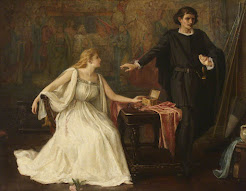Noon (pronounced
noon)
(1) Midday; twelve o'clock in the daytime or the
time or point at which the sun crosses the local meridian (the time of day when the sun is in
its zenith).
(2) Figuratively
(usually in literary or poetic use), the highest, brightest, or finest point or
part; culmination; capstone; apex.
(3)
The corresponding time in the middle of the night; midnight (archaic but
historic use means old documents with the word must be read with care, entries
appearing as both “noon” & “noon of the night”).
(4) Three o’clock in the afternoon (archaic).
(5)
To relax or sleep around midday (as “to noon” “nooning” or “nooned”) (archaic).
(6)
The letter ن in Arabic script.
(7)
Midday meal (archaic).
Pre 900: From the Middle English noen, none & non, from the Old
English nōn (the ninth hour), from a
Germanic borrowing of the Classical Latin nōna
(ninth hour) (short for nōna hōra),
the feminine. singular
of nonus (ninth), contracted from novenos, from novem (nine). It was
cognate with the Dutch noen, the (obsolete)
German non and the Norwegian non.
Synonyms (some archaic) include apex, capstone, meridian, midday,
noontide, noonday, noontime, nones (the ninth
hour of daylight), midpoint (of the day), & twelve. Descendants include the Modern English none
and the Scots nane (none), Noon the
proper noun enduring as a surname. Noun
is a noun and noons, nooning & nooned are verbs; the noun plural is noons.
Although
derived from the Latin word for the number nine, the English word noon
refers to midday, the time when the sun reaches the meridian. The Romans however counted the hours of the
day from sunrise which, for consistency, was declared for this purpose to be
06:00; the ninth hour (nona hora) was
thus 15:00. The early Christians adopted
Jewish customs of praying at certain hours and when Christian monastic orders
formed, the ecclesiastical
reckoning of the daily timetable was structured around the hours for
prayer. In the earliest schedules, the
monks prayed at three-hour intervals: 6-9 pm, 9 pm-midnight, midnight-3 am and
3-6 am. The prayers are known as the
Divine Office and the times at which they are to be recited are the canonical
hours:
Vigils: night
Matins: dawn
Lauds: dawn
Prime: 6 am (first hour)
Terce: 9 am (third hour)
Sext: noon (sixth hour)
None: 3 pm (ninth hour)
Vespers: sunset
Compline: before bed
The shift in the common meaning of noon from 3 pm to 12 noon began in the twelfth century when the prayers said at the ninth hour were set back to the sixth, the reasoning practical rather theological, the unreliability of medieval time-keeping devices and the seasonal elasticity of the hours of daylight in northern regions meaning it was easier to standardise on an earlier hour. Additionally, in monasteries and on holy days, fasting ended at nones, which perhaps offered another administrative incentive to nudge it up the clock. An alternative explanation offered by social historians is that it was simply the abbots deciding to align their noon meal with those taken in the towns and villages, the Old English word non having assumed the meaning “midday” or “midday meal” by circa 1140. Whatever the reason, the meaning shift from "ninth hour" to "sixth hour" seems to have been complete by the fourteenth century, the same path of evolution as the Dutch noen). Noon is an example of what etymologists call a fossil word, one which that embeds customs of former ages.
The
use as a synonym for midnight existed between the seventeenth & nineteenth
centuries, apparently because the poetic phrase “noon of the night” entered
popular use. The noun forenoon (the
morning (ie (be)fore + noon)) applied especially the latter part of it, those
hours “when business is done”, the word emerging circa 1500. The noun noonday (middle of the day) was
first used by Myles Coverdale (1488–1569), the English cleric and
ecclesiastical reformer remembered for his printed translation of the Bible
into English (1535) and it was used as an adjective from 1650s. In the Old English there had been non tid (noon-tide, midday, noon) and non-tima (noon, noon-time, midday). The noun afternoon (part of the day from noon
to evening) dates from circa 1300 and it was subject to an interesting shift in
grammatical form. In the fifteenth &
sixteenth centuries it was used as “at afternoon” but from circa 1600 this
shifted to “in the afternoon”; it emerged as an adjective from the 1570s. In the Middle English there had been the
mid-fourteenth century aftermete (afternoon,
part of the day following the noon meal).
Lindsay Lohan at nuncheon, Scott's Restaurant, Mayfair, London, 2015.
The noun nuncheon was from the mid-fourteenth century nōn-schench (slight refreshment of food (with or without liquor) taken at midday, the name shifting with the meal, nuncheon taken originally in the afternoon (ie notionally the three o’clock meal), the construct being none (noon) + shench (draught, cup), from the Old English scenc, related to scencan (to pour out, to give to drink) and cognate with the Old Frisian skenka (to give to drink) and the German & Dutch schenken (to give). The most obvious descendent of nuncheon is luncheon (and thus lunch).
Lāhainā Noon is the solar phenomenon (known only in the tropics) when the Sun culminates at the zenith at solar noon, passing directly overhead, thus meaning objects underneath cast no shadow, creating a effect something like the primitive graphics in some video games. The name Lāhainā Noon (Lāhainā Noons the plural) was the winner in a contest organised by Hawai'i's Bishop Museum in 1990, the museum noting the word lāhainā (originally lā hainā) may be translated into English as “cruel sun” but makes reference also to the severe droughts experienced in that part of the island of Maui. The old Hawai'ian name for the event was the much more pleasing kau ka lā i ka lolo (the sun rests on the brains).























